DRIVE HOME (Day 26 - part 1)
The giant king-sized bed was sooooo comfy! For the most part, the motel was very quiet. At times, however, the ceiling creaked so much from the person above me that I was worried they were going to fall through!
I hit the road fairly early. Along the way was Sego Canyon (named after the Sego Lily, the state flower of Utah). It offered cliff drawings, an old cemetery and a ghost town. I had read, however, that many of the most impressive buildings had collapsed in the past several years so the town wasn't as worth it, especially when it involved a trek on bumpy dirt roads. But the rock art and cemetery still sounded interesting.

The town of Sego got its start in the early 1890's when a rancher named Harry Ballard discovered coal on the lands adjacent to his property. He quietly bought the area and started a small scale coal operation. The coal was initially dug out manually and hauled down the narrow canyon by wagons. But news spread quickly and soon reached Salt Lake City. Ballard was bought out in 1911 and big production moved in. The new owners built a store, a boarding house, the first coal washer west of the Mississippi River, a tipple (a structure used to coal into railroad cars) and many other structures. The town even had its on spur railroad line running directly to it, and eventually its own post office. At its peak, the mine employed about 125 miners and the town supported around 500 people.

Circa 1926
Unfortunately the problems began immediately: the water supply dried up; there was little or no profit for investors; some miners were not paid for as long as a year (but at least received minimal food and other necessities from the company store); trains were often derailed; power was unreliable; etc. The financial problems finally got so bad that in 1933, the miners reorganized under the United Mine Workers Union and with the union’s help, were finally paid regularly. But that didn't help save the mine. In 1947, it was ordered closed and the property was sold at auction. The remaining 27 miners pooled their money and were able to purchase it.
Victory was to be short-lived though. In 1949, a fire burned the tipple, drastically decreasing production. Then the railroad ceased its operations to Sego. The miners had to purchase dump trucks and loading ramps. The final blow came in the 1950's, when the railroad switched from coal-powered steam engines to diesel engines. Suddenly there was no more huge demand for their product. In 1955, they sold the land to a Texas-based company that was searching for oil and natural gas.
For several decades, the canyon was still lined with many of these old miner cabins and buildings. But in 1973, two carloads of treasure hunters burned most of them down and then sifted through the cooling ashes with metal detectors.


Heading into the canyon

Dirt roads


My first stop was the cemetery. The graves ranged from unmarked dirt mounds, simple wooden crosses and piles of rocks to official gravestones and wooden or metal protective fences.

Quite a view for a final resting place!





Giovanni was a coal miner who died of influenza at the age of 35. Sego was largely by Italians.

Sheldon Bey was born in Cleveland, Ohio, and died in Moab, Utah. He was in the military and worked as a police officer. But that doesn't explain why he rests way out here...

The mysterious Sheldon (Rusty) Frederick Bey Jr.

Among the living was this Collared Lizard. They are known for their ability to run on their hind legs... looking like little tiny raptor dinosaurs. Not this guy, though. It's clearly nap time.
I then drove down to where the rock art was. These cliff walls have been used by various prehistoric cultures for several thousands of years. there are both petroglyphs (chiseled in) and pictographs (painted on). There are three distinct cultures represented here: Archaic, Fremont and Ute. Unfortunately much of it was riddled with graffiti.
PANEL 1: The Utes are part of the Numic or Shoshoean group of Native Americans, which also include the Paiute, Shoshone, Goshute and Comanche. They have been inhabiting this area since the 1300's, mostly in small groups as hunter/gathers and living in tipis. In 1880, however, they were removed from their ancestral lands and placed in a nearby reservation.
Their style of rock art generally features bison, decorated circles and shield-shaped figures. Horses were introduced to the southwest by the Spanish during the 16th century, so any figure containing a horse dates from that period or later.

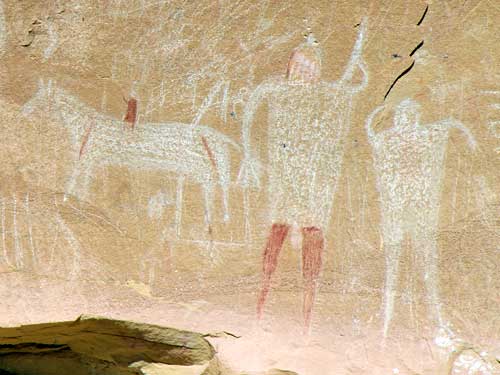
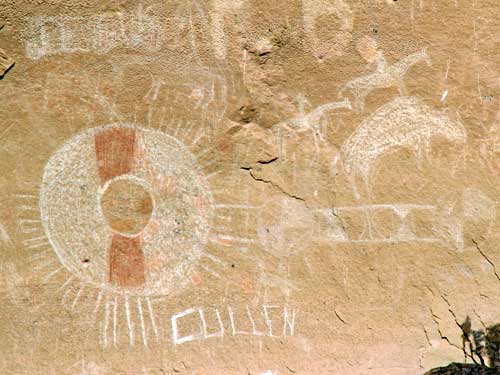
PANEL 2: The Fremont people lived in central Utah from 600 to 1250. Their art contains both petroglyphs and pictographs. Human figures often have trapezoidal shapes. There are also bighorn sheep and other game animals depicted. Spirals are also common.
The oldest figures are at the top of the panel. A new line of etched figures are superimposed on older painted figures.


The older images painted in red loom behind the newer etched drawings.

Remember learning about these Fremont clay figurines from Fruita (Capitol Reef)?


A Bighorn sheep and a beaver

Uh... I have no idea!!
The graffiti was truly ridiculous! It covered absolutely everything and spanned the course of 130 years. It ranged from simple initials and dates to drawings of naked women and lewd sayings. Again the question begged to be asked... at what year does graffiti turn into history? 1884? 1902? 1928? 1941? 1952? 1985? 2014??

It's true we will probably never know who carved this, but it's fun to bumble through historical records and see who MIGHT have. Nelson Gay Whipple (1859 - 1944) was the fifth son of Nelson Wheeler Whipple (1818 - 1887) and Susan Ann Gay (1846 - 1911). They were Mormons who began their move to Utah in the 1840's. Gay (as he was referred to) would have been 25 years old at the time of this carving. Possible?? He is mentioned as owning a furniture business in Lehi (south of Salt Lake City) in the early 1880's and credited with building the local band wagon together with William Goates.
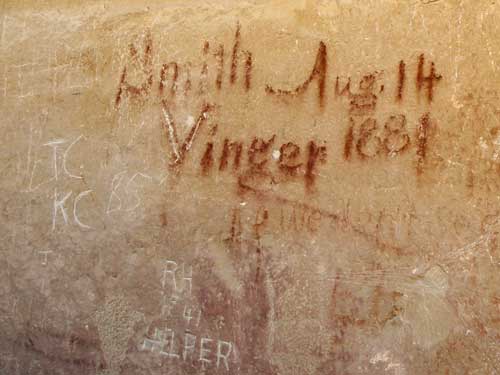
At first I thought this might be two names... Smith and Vinger. But what if it's just one... Caroline Smith Wilberg (1827 -1909) was born in Norway, the daughter of Christen Christiansen Winger and Ratine Maria Smith. How would one pronounce Winger with a Norwegian accent?... Vinger. She married Lars Olsen Wilberg at the age of 24 (he was 36 and this was his third marriage). It's unclear when she arrived in Utah. She would have been 57 when this was carved. She died at age 82 and is buried in Castle Dale, Utah... only about 100 miles from Sego. Possible??

1902
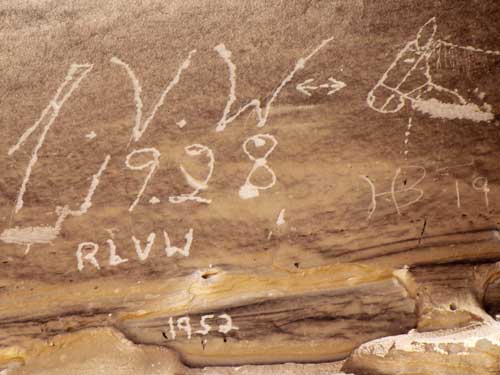
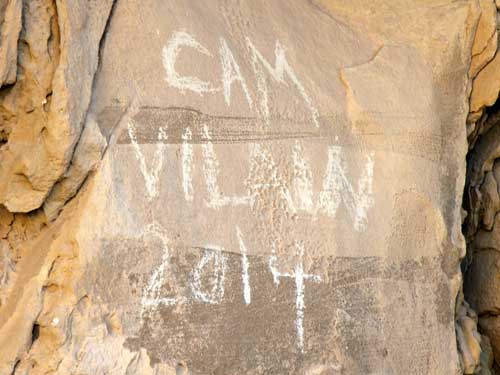
I could understand people doing this until the 1950's, around the time when we started to know better. But there is no excuse at this point.
PANEL 3: The Archaic period dates back from 7000 BC, although this art style, known as 'Barrier Canyon' (named after a site along Barrier Creek in Horseshoe Canyon in Canyonlands National Park), dates from around 2000 BC. It usually contains larger-than-life human-like figures. They often have hollowed or missing eyes, horns or antennae, are missing arms or legs, and have body decorations. Barrier Canyon rock art is found in Utah, Colorado and Arizona.
This main panel contains 19 large figures. I have to admit, it actually felt a bit creepy looking at them.

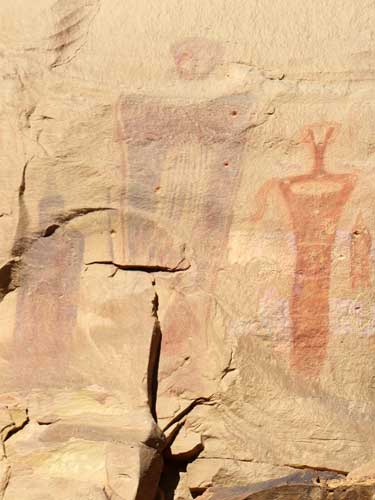

Remember, this stuff could be up to 4,000 years old! What were they trying to say??


Just down the road was another panel of figure. One panel was more Barrier Canyon pictographs while the other was mostly petroglyphs (probably Fremont).

Walking past some potential mining history

An old cattle corral guards the two panels.

Panel 1

These drawings were extremely intimidating!

For scale, I'm about 5'8". I felt VERY uncomfortable taking this photo. It truly felt as if I were standing next to a living being... a very scary living being!!

Again... thousands of years old! What was life like back then?!

Some smaller drawings up higher

Panel 2


Your guess is as good as mine!

Ah, so THAT'S what he's trying to tell us!
return • continue

